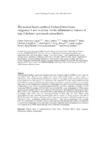Mostrar o rexistro simple do ítem
The nuclear factor-erythroid 2-related factor/heme oxygenase-1 axis is critical for the inflammatory features of type 2 diabetes–associated osteoarthritis
| dc.contributor.author | Vaamonde-García, Carlos | |
| dc.contributor.author | Courties, Alice | |
| dc.contributor.author | Pigenet, Audrey | |
| dc.contributor.author | Laiguillon, Marie-Charlotte | |
| dc.contributor.author | Sautet, Alain | |
| dc.contributor.author | Houard, Xavier | |
| dc.contributor.author | Kerdine-Römer, Saadia | |
| dc.contributor.author | Meijide-Faílde, Rosa | |
| dc.contributor.author | Berenbaum, Francis | |
| dc.contributor.author | Sellam, Jérémie | |
| dc.date.accessioned | 2018-01-18T10:21:16Z | |
| dc.date.available | 2018-01-18T10:21:16Z | |
| dc.date.issued | 2017-07-06 | |
| dc.identifier.citation | Vaamonde-Garcia C, Courties A, Pigenet A, Laiguillon MC, Sautet A, Houard X, Kerdine-Römer S, Meijide R, Berenbaum F, Sellam J. The nuclear factor-erythroid 2-related factor/heme oxygenase-1 axis is critical for the inflammatory features of type 2 diabetes-associated osteoarthritis. J Biol Chem. 2017 Sep 1;292(35):14505-14515. | es_ES |
| dc.identifier.issn | 0021-9258 | |
| dc.identifier.issn | 1083-351X | |
| dc.identifier.uri | http://hdl.handle.net/2183/20008 | |
| dc.description.abstract | [Asbtract] Epidemiological findings support the hypothesis that type 2 diabetes mellitus (T2DM) is a risk factor for osteoarthritis (OA). Moreover, OA cartilage from patients with T2DM exhibits a greater response to inflammatory stress, but the molecular mechanism is unclear. To investigate whether the antioxidant defense system participates in this response, we examined here the expression of nuclear factor-erythroid 2-related factor (Nrf-2), a master antioxidant transcription factor, and of heme oxygenase-1 (HO-1), one of its main target genes, in OA cartilage from T2DM and non-T2DM patients as well as in murine chondrocytes exposed to high glucose (HG). Ex vivo experiments indicated that Nrf-2 and HO-1 expression is reduced in T2DM versus non-T2DM OA cartilage (0.57-fold Nrf-2 and 0.34-fold HO-1), and prostaglandin E2 (PGE2) release was increased in samples with low HO-1 expression. HG-exposed, IL-1β-stimulated chondrocytes had lower Nrf-2 levels in vitro, particularly in the nuclear fraction, than chondrocytes exposed to normal glucose (NG). Accordingly, HO-1 levels were also decreased (0.49-fold) in these cells. The HO-1 inducer cobalt protoporphyrin IX more efficiently attenuated PGE2 and IL-6 release in HG+IL-1β-treated cells than in NG+IL-1β-treated cells. Greater reductions in HO-1 expression and increase in PGE2/IL-6 production were observed in HG+IL-1β-stimulated chondrocytes from Nrf-2−/− mice than in chondrocytes from wild-type mice. We conclude that the Nrf-2/HO-1 axis is a critical pathway in the hyperglucidic-mediated dysregulation of chondrocytes. Impairments in this antioxidant system may explain the greater inflammatory responsiveness of OA cartilage from T2DM patients and may inform treatments of such patients. | es_ES |
| dc.description.sponsorship | Agence Nationale de la Recherche (France); ANR-11-IDEX-0004-02 | es_ES |
| dc.language.iso | eng | es_ES |
| dc.publisher | American Society for Biochemistry and Molecular Biology | es_ES |
| dc.relation.uri | http://dx.doi.org/10.1074/jbc.M117.802157 | es_ES |
| dc.subject | Diabetes | es_ES |
| dc.subject | Heme oxygenase | es_ES |
| dc.subject | Inflammation | es_ES |
| dc.subject | Nuclear factor 2 (erythroid-derived 2-like factor) (NFE2L2) (Nrf2) | es_ES |
| dc.subject | Osteoarthritis | es_ES |
| dc.title | The nuclear factor-erythroid 2-related factor/heme oxygenase-1 axis is critical for the inflammatory features of type 2 diabetes–associated osteoarthritis | es_ES |
| dc.type | info:eu-repo/semantics/article | es_ES |
| dc.rights.access | info:eu-repo/semantics/openAccess | es_ES |
| UDC.journalTitle | Journal of Biological Chemistry | es_ES |
| UDC.volume | 292 | es_ES |
| UDC.startPage | 14505 | es_ES |
| UDC.endPage | 14515 | es_ES |
Ficheiros no ítem
Este ítem aparece na(s) seguinte(s) colección(s)
-
GI-TCMR - Artigos [126]






